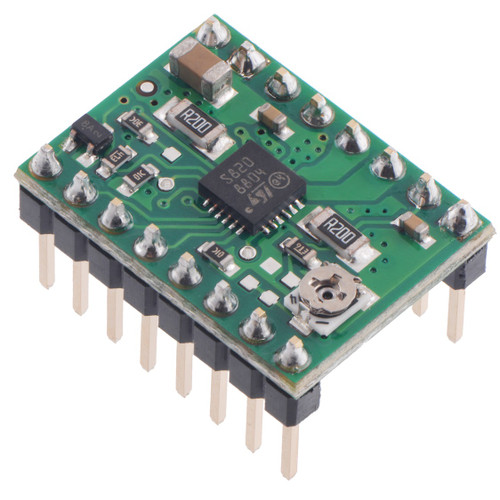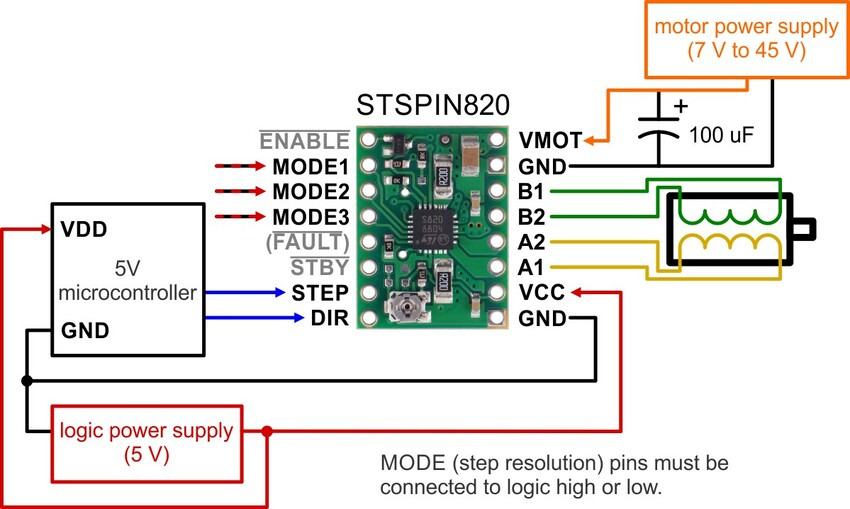
STSPIN820 Stepper Motor Driver Carrier (Connectors Soldered)
| SKU: | 303 |
This version of Pololu's STSPIN820 Stepper Motor Driver Carrier ships with male header pins installed, so no soldering is required to use it with an appropriate 16-pin socket or solderless breadboard.
This breakout board for STMicro’s STSPIN820 microstepping bipolar stepper motor driver offers microstepping down to 1/256-step and a wide operating range of 7 V to 45 V. It can deliver up to approximately 0.9 A per phase continuously without a heat sink or forced air flow (up to 1.5 A peak). The module has a pinout and interface that are very similar to that of the popular A4988 carriers, so it can be used as a drop-in replacement for those boards in many applications.
This product is a carrier board or breakout board for the STSPIN820 stepper motor driver from STMicroelectronics (ST); we therefore recommend careful reading of the STSPIN820 datasheet (594k pdf) before using this product. This stepper motor driver offers microstep resolutions down to 1/256 of a step, and it lets you control one bipolar stepper motor at up to approximately 0.9 A per phase continuously without a heat sink or forced air flow (see the Power dissipation considerations section below for more information). Here are some of the driver’s key features:
- Simple step and direction control interface
- Eight different step resolutions down to 256 microsteps: full-step, half-step, 1/4-step, 1/8-step, 1/16-step, 1/32-step, 1/128-step, and 1/256-step
- Adjustable current control lets you set the maximum current output, which lets you use voltages above your stepper motor’s rated voltage to achieve higher step rates
- Motor supply voltage: 7 V to 45 V
- Can deliver 0.9 A per phase continuously without additional cooling
- Can interface directly with 3.3 V and 5 V systems
- Over-temperature thermal shutdown, over-current shutdown, and short circuit protection
- 4-layer, 2 oz copper PCB for improved heat dissipation
- Exposed solderable ground pad below the driver IC on the bottom of the PCB
- Module size, pinout, and interface match those of A4988 stepper motor driver carriers in most respects
Using the Driver

Power connections
The driver requires a logic supply voltage (3 – 5 V) to be connected across the VCC and GND pins and a motor supply voltage of 7 V to 45 V to be connected across VIN and GND. These supplies should have appropriate decoupling capacitors close to the board, and they should be capable of delivering the expected currents (peaks up to 3 A for the motor supply).
Motor connections
The STSPIN820 is intended to control a single bipolar stepper motor. The two sides of one coil should be connected across OUTA1 and OUTA2, and the two sides of the other coil should be connected across OUTB1 and OUTB2.
Step (and microstep) size
Stepper motors typically have a step size specification (e.g. 1.8° or 200 steps per revolution), which applies to full steps. A microstepping driver such as the STSPIN820 allows higher resolutions by allowing intermediate step locations, which are achieved by energizing the coils with intermediate current levels. For instance, driving a motor in quarter-step mode will give the 200-step-per-revolution motor 800 microsteps per revolution by using four different current levels.
The resolution (step size) selector inputs (MODE1, MODE2, and MODE3) enable selection from the eight step resolutions according to the table below. These three pins are floating, so the MODE pins must be connected to logic high or low before operating the driver. For the microstep modes to function correctly, the current limit must be set low enough (see below) so that current limiting gets engaged. Otherwise, the intermediate current levels will not be correctly maintained, and the motor will skip microsteps.
| MODE1 | MODE2 | MODE3 | Microstep Resolution |
|---|---|---|---|
| Low | Low | Low | Full step |
| High | Low | Low | Half step |
| Low | High | Low | 1/4 step |
| High | High | Low | 1/8 step |
| Low | Low | High | 1/16 step |
| High | Low | High | 1/32 step |
| Low | High | High | 1/128 step |
| High | High | High | 1/256 step |
Control inputs and status outputs
The rising edge of each pulse to the STEP (STCK) input corresponds to one microstep of the stepper motor in the direction selected by the DIR pin. Unlike most of Pololu's other stepper motor driver carriers, the STEP and DIR inputs are floating, so they must be connected to logic high or low to ensure proper operation.
The STSPIN820 IC has two different inputs for controlling its power states, STBY/RESET and EN/FAULT:
- When the STBY pin is driven low, the driver enters a low-power mode, disables the motor outputs, and resets the translation table. This pin is called STBY on the board based on the logic of how it works, but it is a direct connection to the STBY pin on the driver.
- The EN pin is inverted by the carrier board and presented as ENABLE, which makes it the same way as the enable pins on Pololu's various other stepper motor drivers with this form factor. It is pulled low on the board to enable the driver by default, and it can be driven low to disable the outputs.
The STSPIN820 can detect several fault (error) states that it reports by driving EN/FAULT pin on the driver low. The FAULT pin is not made available by default (to avoid conflicts when using the STSPIN820 carrier as a drop-in replacement for our other stepper motor driver carriers), but it can be connected to the pin labeled “( FLT )” by bridging the surface mount jumper labeled “F” on the bottom side of the board.
On this carrier, the DECAY input is pulled down with a 10k resistor that sets the driver to mixed decay mode. The driver can be set to slow decay mode by bridging the surface mount jumper labeled “D” on the bottom side of the board.

Current limiting
To achieve high step rates, the motor supply is typically higher than would be permissible without active current limiting. For instance, a typical stepper motor might have a maximum current rating of 1 A with a 5 Ω coil resistance, which would indicate a maximum motor supply of 5 V. Using such a motor with 10 V would allow higher step rates, but the current must actively be limited to under 1 A to prevent damage to the motor.
The STSPIN820 supports such active current limiting, and the trimmer potentiometer on the board can be used to set the current limit. You will typically want to set the driver’s current limit to be at or below the current rating of your stepper motor. One way to set the current limit is to put the driver into full-step mode and to measure the current running through a single motor coil without clocking the STEP input. The measured current will be equal to the current limit (since both coils are always on and limited to 100% of the current limit setting in full-step mode).
Another way to set the current limit is to measure the VREF voltage and calculate the resulting current limit. The current limit relates to VREF as follows:
current limit = VREF x 5 A/V
Power dissipation considerations
The driver ICs have maximum current ratings higher than the continuous currents we specify for these carrier boards, but the actual current you can deliver depends on how well you can keep the IC cool. The carrier’s printed circuit board is designed to draw heat out of the IC, but to supply more than the specified continuous current per coil, a heat sink or other cooling method is required.
Please note that measuring the current draw at the power supply will generally not provide an accurate measure of the coil current.Since the input voltage to the driver can be significantly higher than the coil voltage, the measured current on the power supply can be quite a bit lower than the coil current (the driver and coil basically act like a switching step-down power supply). Also, if the supply voltage is very high compared to what the motor needs to achieve the set current, the duty cycle will be very low, which also leads to significant differences between average and RMS currents. Additionally, please note that the coil current is a function of the set current limit, but it does not necessarily equal the current limit setting as the actual current through each coil changes with each microstep and can be further reduced if Active Gain Control is active.
This schematic is available as a downloadable pdf (109k pdf).
Recommended links
- STSPIN820 documentation and resources
- ST’s product page for the STSPIN820 Advanced 256 microsteps integrated motor driver with step-clock and direction interface, with links to its most up-to-date datasheet and other resources.
Dimensions
| Size: | 0.6″ × 0.8″ |
|---|---|
| Weight: | 1.4 g |
General specifications
| Motor driver: | STSPIN820 |
|---|---|
| Minimum operating voltage: | 7 V |
| Maximum operating voltage: | 45 V |
| Continuous current per phase: | 0.9 A |
| Maximum current per phase: | 1.5 A |
| Minimum logic voltage: | 2 V |
| Maximum logic voltage: | 5.5 V |
| Microstep resolutions: | full, 1/2, 1/4, 1/8, 1/16, 1/32, 1/128, 1/256 |
| Current limit control: | potentiometer |
| Reverse voltage protection?: | N |
| Header pins soldered?: | Y |
Identifying markings
| PCB dev codes: | md37a |
|---|---|
| Other PCB markings: | 0J11739 |



